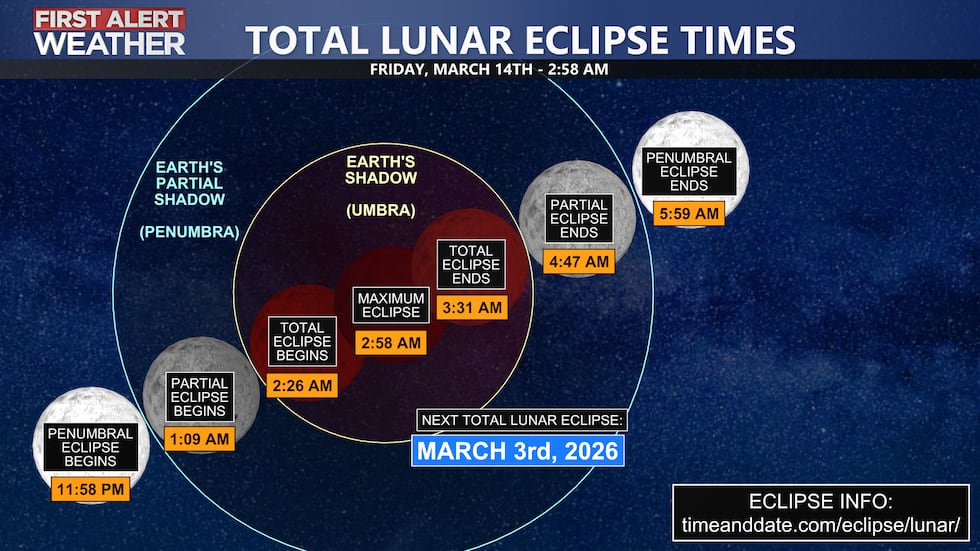Weather blog: What you need to know about 2025 total lunar eclipse
Best time for viewing in the CSRA is between 2:30 - 3:30 AM Friday morning.
AUGUSTA, Ga. (WRDW/WAGT) - There is a special astronomical event happening early Friday morning. A total lunar eclipse will occur with a maximum eclipse at 2:58 a.m. A lunar eclipse occurs when the sun, Earth, and moon all align perfectly to allow the Earth to cast a shadow on the moon.

There are two parts to the shadow Earth creates. The outer part of the shadow is called the penumbra and starts to move over the moon first. When the moon es through the penumbra, it will look like the moon is starting to get slightly darker. The center of Earth’s shadow is known as the umbra. As Earth’s umbra is cast over the moon, you can expect to see an orange/reddish glow from the moon’s surface. As this happens, the moon takes on a reddish hue, earning it the name “Blood Moon”.
Per Space.com: “This effect occurs because Earth’s atmosphere scatters shorter wavelengths of sunlight while allowing longer wavelengths — red and orange light — to bend into Earth’s shadow and illuminate the moon. It’s the same phenomenon that gives sunrises and sunsets their rich colors. The total lunar eclipse will be visible in North America, South America, western parts of Europe and Africa on Thursday, March 13 into Friday, March 14.”
The peak time when the moon is covered by the umbra is 2:58 a.m. for the Augusta/Aiken area. The eclipse will take place between 12 - 6 a.m. Friday. The best viewing of the eclipse for the CSRA will be between 2:30 and 3:30 a.m. This is a " total " lunar eclipse because the moon will completely through the umbra. Despite the early time of the maximum eclipse, it will definitely be worth checking out!
It has been nearly three years since the last total lunar eclipse. This will be the first total lunar eclipse since November 2022 and the first of three set to occur between 2025 and 2026.
VIEWING TIPS:
Unlike solar eclipses, lunar eclipses are completely safe to observe with the naked eye. No special equipment is needed, but using binoculars or a telescope can enhance the experience, revealing intricate details on the moon’s surface. The best way to watch is from a location away from city lights with an unobstructed view of the sky. Be sure to check the forecast and plan your viewing spot. Clouds look possible late Thursday into early Friday for the CSRA.
Here are some videos from First Alert Chief Meteorologist Riley Hale and First Alert Meteorologist Mikel Hannah-Harding about Friday morning’s eclipse:
Copyright 2020 WRDW/WAGT. All rights reserved.















